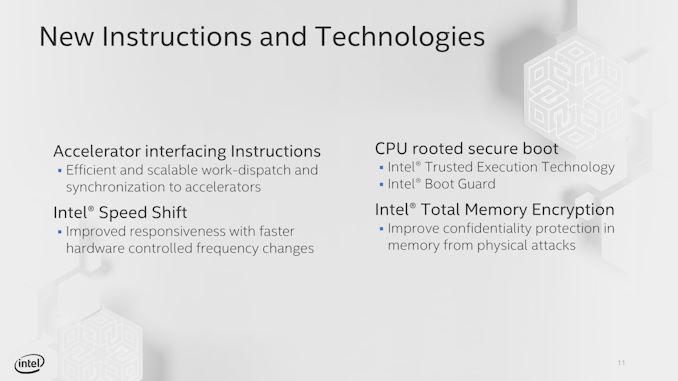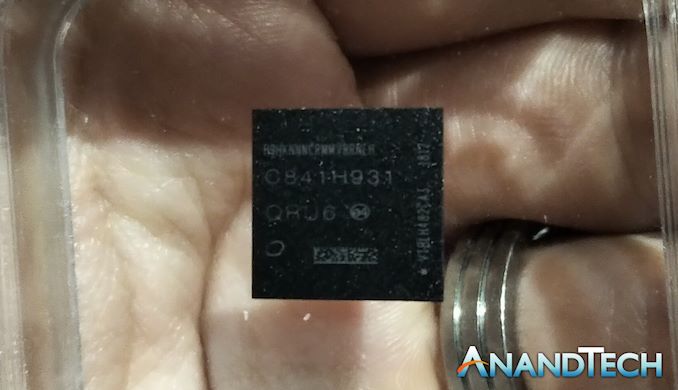Intel's new Atom Microarchitecture: The Tremont Core in Lakefield
by Dr. Ian Cutress on October 24, 2019 1:30 PM ESTBeyond the Core
Nominally today’s disclosure is more about the Tremont microarchitecture than any SoC it might appear in, like Lakefield or Snow Ridge. To that end, Intel wasn’t talking about GPU support (Lakefield will have Gen11 graphics), but Intel did discuss that Tremont would be the first Atom design to fully support Intel’s Speed Shift / ACPI hardware flags, allowing for faster ramp-up and ramp-down of high-frequency operation.
Intel also stated that Tremont supports Total Memory Encryption to prevent physical attacks, Rooted Secure Boot and Boot Guard, and specific accelerator interfacing instructions. With respect to Spectre, Meltdown, and L1TF, Intel stated that Tremont will have the same protections as Cascade Lake.
We also asked Intel about module-level voltage and power control. We were told that within a quad-core module with four Tremont cores, all the cores share the same frequency plane, but each core can enter separate c-states to reduce power consumption when not in use.
Final Thoughts and Slide Deck
In the past, at least from my perspective, dealing with Atom platforms has been amusing. Atom devices typically work great for hyper-focused and optimized software that can take advantage of a latency-insensitive workload, such as networking equipment or a NAS, but for any general purpose use I find them incredibly slow. Perhaps I’m just too used to the big cores on the devices I use – but with Intel saying that Atom is being refocused on performance, it will be interesting to see how Tremont devices and other Core devices will overlap. This graph from Intel is very striking, and if you squint, it looks a lot like some of the smartphone power/performance graphs we’ve produced in the past.
With Intel moving Core down in power to the 1.5W level, again it will be interesting to see how Tremont can play in that 2mW to 2W range that Atom has traditionally played in. The last generation Goldmont Plus devices were going beyond that, and in this power range we also have smartphone cores coming into play. After showing the slide deck to Andrei, we were discussing how a Tremont might stack up against an Arm Cortex A76, or a Kryo core. When we can get our hands on Tremont, we’ll see how they compare. When it comes to the products that Tremont is aiming for however, it still has that x86 advantage.
We did ask a few questions from Intel that we didn’t get answers to, such as die size and target frequencies. The other question to discuss is Intel’s current high-demand issues putting pressure on its manufacturing technologies. Tremont is still a low cost, low powered core, so logic may dictate that it will be a while before we see consumer chips enter the market. Ultimately Intel’s high-demand issues are around 14nm, and so far we’ve only seen Tremont discussed on Intel’s 10+ process with Lakefield and Snow Ridge. What we know about Intel’s 10nm/10+ capacity isn’t a lot, but reports vary from yields being ‘on track’ to ‘working with key OEM partners only’. Intel’s driver for 10+ right now is Ice Lake, which is coming to some premium notebook designs this year, and Lakefield has been announced for the Surface Neo. It is not known what the expected volume for the Neo will be, but it is unlikely to be large. Whether or not Tremont will see the light of day in traditional Atom Celeron and Pentium processors is another question entirely – the Goldmont Atom families have suffered while Intel’s 14nm efforts are more focused on enterprise hardware that can be sold for a much higher $$ per square millimeter. Beyond Lakefield, we might not actually see Tremont in any other consumer chip before the next generation Atom if Intel cannot get its issues sorted.
As and when we get a Lakefield device, we will put it through our tests. Stay tuned.













101 Comments
View All Comments
vladx - Friday, October 25, 2019 - link
Obviously Intel waited until it was left with no choice.Ratman6161 - Friday, October 25, 2019 - link
"Did Atom processors ever stop sucking?"Actually I don't believe they ever started sucking. As with many things, once OEM's decided they were for cheap systems, they built systems where everything else was cheap too. Atom was never designed for high performance and when you combined it in a laptop where everything in it was the cheapest the manufacturer could get...you got crap. I think within its niche it wasn't really half bad.
I've Got an Asus Zenbook S8 with an Atom Z3580 running Android 6 and it was actually pretty fast for an Android tablet of its day. It competed well with Samsung's tablets at that time and was a fraction of the cost ($249 on Amazon back then). I still use it and its still more than adequate for web surfing, email, Netflix, Amazon Prime video etc. Keep Atom where it belongs and don't set unreasonably high expectations for it and it doesn't suck.
mode_13h - Saturday, October 26, 2019 - link
I dunno... did x86 processors ever stop sucking?They do deliver good perf/W - better than Intel's big cores, but still not as good as ARM.
Korguz - Sunday, October 27, 2019 - link
" if they are not as good as arm " how so ??Namisecond - Friday, November 1, 2019 - link
Not as good perf/W but we are comparing ARM to x86 here.olde94 - Saturday, October 26, 2019 - link
that widely depends on your application. as far as i understand atoms are widely used in servers due to their power consumption, low heat output and focus on CPU performance compared to other mainstream cpu's. so yeah for some applications atoms are quite ok.olde94 - Saturday, October 26, 2019 - link
a system like this https://www.supermicro.com/products/system/3U/5039... is a single server rack with a total of 192 cores at less than 400W. and while it's atom cores i would like to have you realize that they run at 2.1ghz, wheres a system like a Gold CPU 6148 x2 is a 40 core @2.4ghz at above 300w. so while the xeon has better IPC we are talking about a 40c vs 192c system at a comparable power budget runing a frequency that is similar. so the xean need more then 4x better IPC to win here. once again there are a lot of features the atom does not support and the IPC surely is different, but atom is not "just" badCalista - Sunday, October 27, 2019 - link
Atom have come a really long way from its earliest versions. Try using something like a N270 and compare it to an X5-E8000. The former will be completely unusable, the later not really zippy but more than fast enough for most common workloads except gaming.yeeeeman - Sunday, March 15, 2020 - link
Silvermont based tablets that sold at 100 bucks were amazing value for money.You should stop sucking whatever you are sucking, because atom was quite good after silvermont launched.
ternnence - Thursday, October 24, 2019 - link
The two ALUs have one focused on fused additions (FADD), while the other focuses on fused multiplication and division (FMUL).fadd != fused add, fadd = float point add